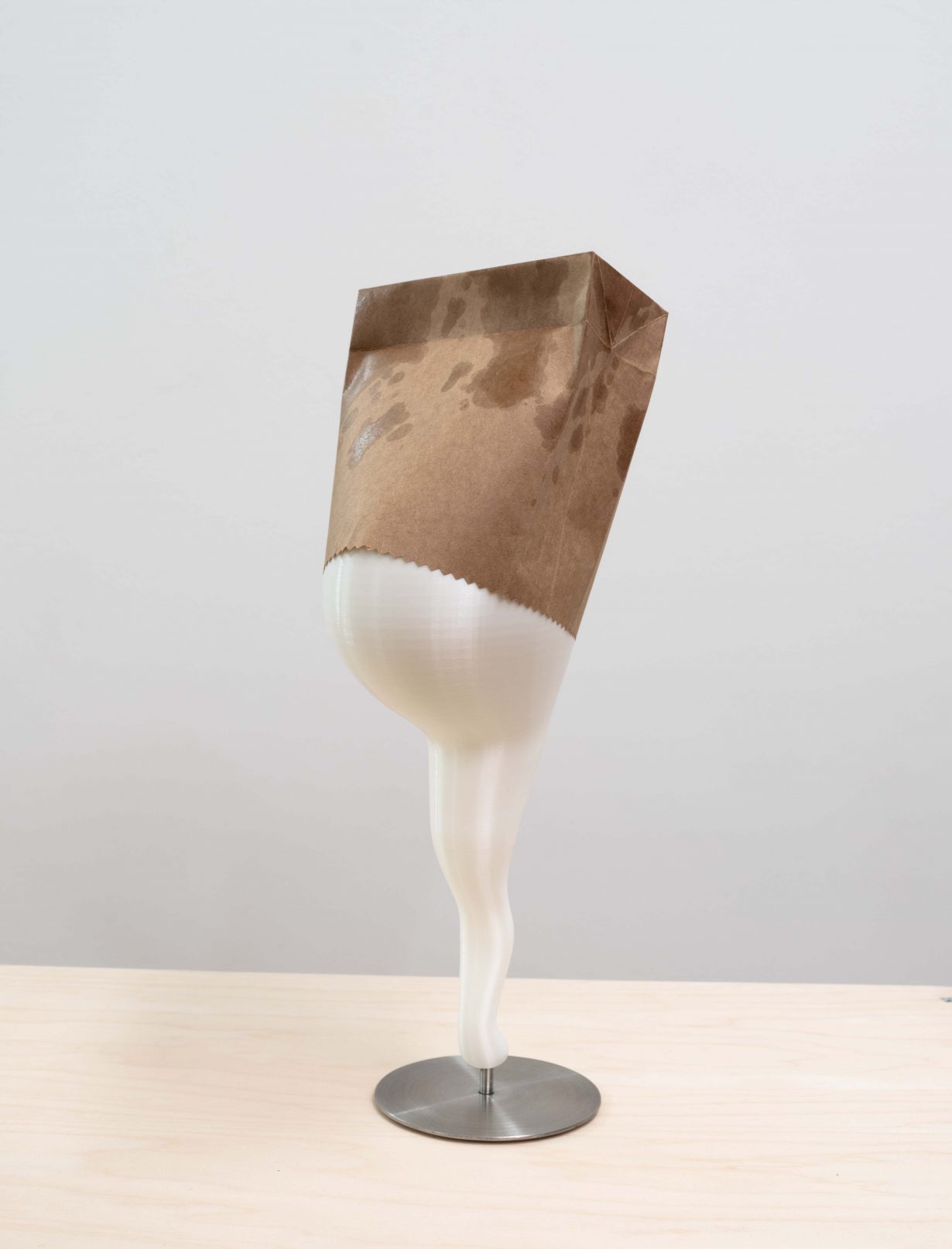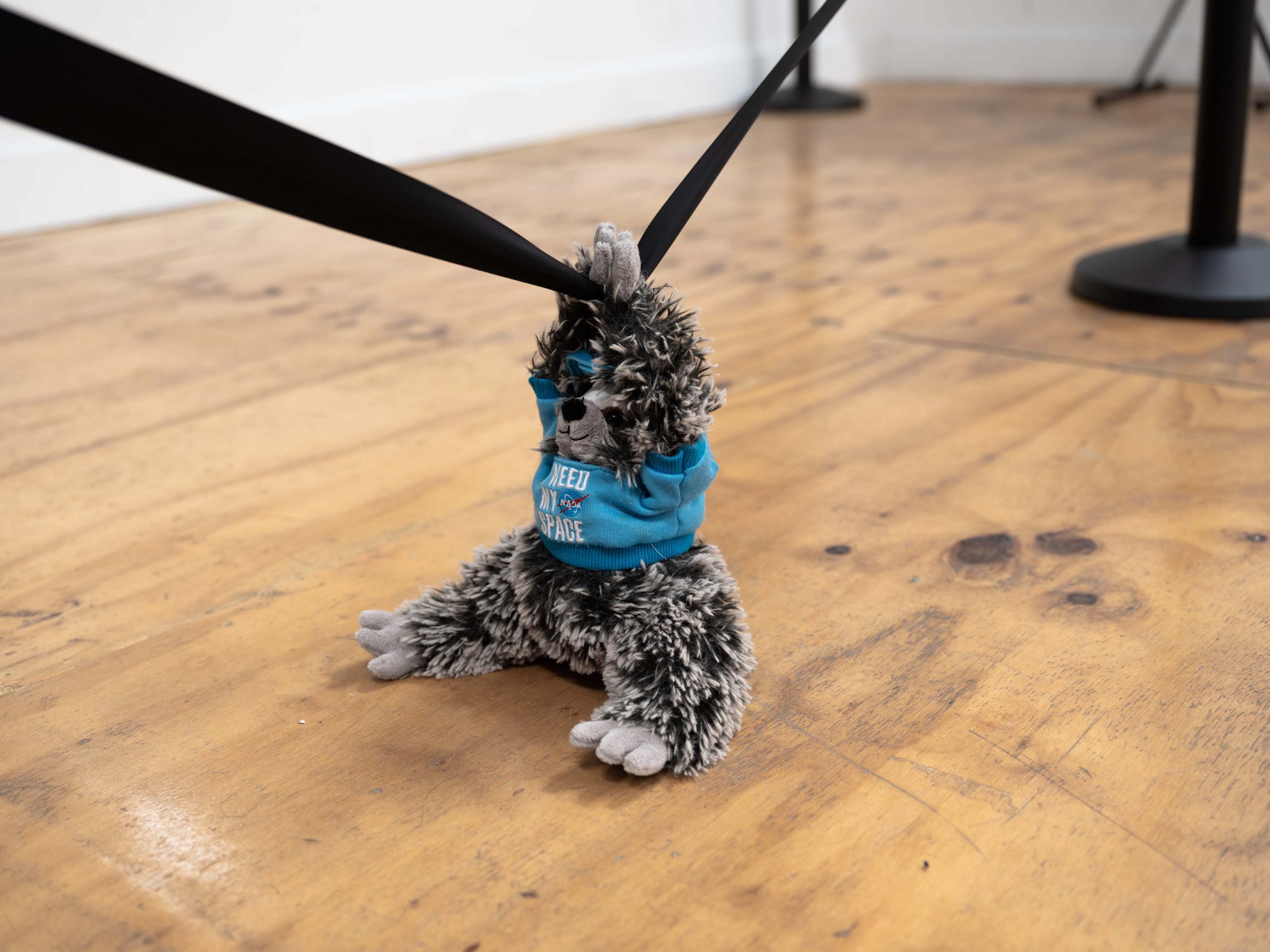Queues at Kapp Kapp, New York is deeply self-aware, self-critical, self-sabotaging – and yet somehow quite endearing
Rows of stanchions fill Kapp Kapp, guiding viewers past 17 artworks – readymade assemblages, 3D-printed sculptures and site-specific interventions – installed along the gallery’s walls. While congested queues might trigger restlessness and resentment, a serpentine configuration of stanchions and belts standing empty, as this one does during the gallery’s weekday lulls, exudes an aura of deluded optimism tinted with deadpan humour, a trademark of the work of Brooklyn-born interdisciplinary artist Louis Osmosis.
The exhibition can be traversed in either direction. Viewed in ‘chronological’ order, which requires walking from the back storage room up towards the gallery’s entrance, it tells a sad tale of middle-class American striving beginning from conception, represented by a group of anthropomorphic sperm sculptures. The largest of these cartoonish flagellates is made of papier-mâché and titled Big Mascot (Ragamuffin) (all works 2024). Beside it are six 3D-printed Small Mascots the size of collectible figurines. Faceless, they are differentiated by their head-gear – a propeller beanie, a horned helmet and a conical Asian sunhat among them. The irreverence of these sculptures comes as no surprise given Osmosis’s previous solo show at Kapp Kapp, in which he exhibited a kawaii human-size papier-mâché cockroach named Companion (Hachikō) (2022).
Next to the Small Mascots is Incubator, a rectangular aperture in the gallery’s wall. Instead of a view – of an infant, eggs or something in the vein of Duchamp’s Étant donnés (1966) – the window contains a double-sided mirror that, in most lighting conditions, simply reflects the face of the person peering into it. Childhood is represented by Chair with Pipe, a vintage floral-patterned highchair whose seat and tray table are penetrated by a long steel pipe. This work’s conceit, as well as its title, pay homage to the American sculptor Robert Gober, who drove pipes through objects including an armchair and a statue of the Virgin Mary. Next to the highchair stands another sculpture, Smokin’ Tiki. Here, an acrylic tube holds up a riot shield with a lit cigarette doodled on its surface. The sculpture’s title hints at the deadly ‘Unite the Right’ rally that took place in Charlottesville, Virginia, in 2017, during which American white nationalists brandished tiki torches and clashed with police. Read together, the two sculptures tell the story of a baby raised by a volatile conservative parent.

Nearby, two Content House assemblages stand in for the entrepreneurial and interpersonal endeavours of young adulthood. The ‘content house’, a residence in which social-media influencers cohabitate and collaborate, is pictured here as an amalgam of boxes and fabric. In Content House, for Los Angeles, a wedding gown spills out from a shelf beneath a pile of PVC pipes, while in Content House, for New York, yellowed nylon cascades from a stack of boxes including a quaint, half-empty Valentine’s gift set. Despite their titles, Osmosis’s Content House assemblages do not foreground digital technology, nor do they contain specific references to the influencer economy. Instead, they adopt the visual language of late-1960s Italian Arte Povera, whose artists made use of preindustrial materials like soil, rocks and fabric to critique modernism and technology. In a sense rebranding the principles of Arte Povera for a contemporary audience, Osmosis undercuts the visual abundance and sensorial stimulation associated with the phrase ‘content house’ with the mute vernacular artefacts of an analogue past.
Continually thwarting expectations, Queues accelerates through the trials of adulthood and homeownership, encapsulated in three Foreclosure sculptures – bundles of papier-mâché ‘firewood’ mounted on a watermarked photo of the Statue of Liberty – towards its final work, Score, for Ellipsis & Roundtable, a readymade comprising a foldable electronic keyboard, a muttering AM radio and three Mylar balloons floating like the melancholy decor of a retirement party. According to the press release, these decorations reference the deflated black balloons the artist Pope. L scattered throughout his 2013 exhibition Forlesen at The Renaissance Society, in Chicago.
In a 2023 talk Osmosis cited Pope. L’s polemic on the commodification of live performance art, ‘Canary in the Coal Mine’ (2011), as a major influence on his practice. ‘Let’s say live performance art is some kind of canary in the coal mine,’ Pope. L writes. ‘What is its death trying to tell us? Or more interestingly, its middle years, what are they trying to tell us about a form that lives and dies on liveness?… After life, we, performance artists, should sell what? Tacos? Medical supplies for diabetes?’ The late artist concludes, ‘the next product for us, performance artists, to sell is the soul’. The central conundrum of Osmosis’s show – while it does not include performance art – extends from Pope. L’s proposition: having surrendered their souls to an attention economy that not only instantaneously commodifies liveness and authentic experience but also propagates political extremism and disinformation, what should artists today sell?
Without a clear answer, Queues comes across as a deeply self-aware, self-critical and even self-sabotaging show that leaves the viewer with a sense of what scholar Ackbar Abbas terms déjà disparu – ‘the feeling that what is new and unique about the situation is always already gone, and we are left holding a handful of clichés’. Indeed, when viewed in reverse chronological order, from entrance to storage room, the American life that Queues depicts issues from a state of obsolescence, encapsulated in Score, for Ellipsis & Roundtable. From there, we age in reverse, each failure – the foreclosed home, the discarded wedding dress – further infantilising us. Traverse the room more than once, and the beginning and end of life start to loop and become indistinguishable.
In lieu of progress and emotional growth, that which insinuates itself in Queues is a vague nostalgia for a fabled time when the stanchions of capitalist striving were packed, when a spot in line, even in the back, was worth fighting for. Ultimately, the viewer gets the sense that Osmosis’s casual indifference is a pose, one that betrays a great tenderness towards vernacular histories and his artistic progenitors – hence, the domestic paraphernalia, the pointed references to social dysfunction and the intergenerational homages. This makes the dreariness of the scene at hand not only bearable to behold but also surprisingly endearing, in spite of itself.
Queues at Kapp Kapp, New York, 20 January – 9 March
